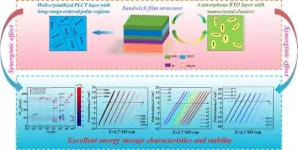(Press-News.org) The lipids in some herbal teas have been identified in detail for the first time, preparing the ground for investigating their contribution to the health benefits of the teas.
Herbal teas are enjoyed worldwide, not only for their taste and refreshment but also for a wide range of reputed health benefits. But the potential significance of a category of compounds called lipids in the teas has been relatively unexplored. Researchers at Hokkaido University, led by Associate Professor Siddabasave Gowda and Professor Shu-Ping Hui of the Faculty of Health Sciences, have now identified 341 different molecular species from five categories of lipids in samples of four types of herbal tea. They published their results in the journal Food Chemistry.
Lipids are a diverse collection of natural substances that share the property of being insoluble in water. They include all of the fats and oils that are common constituents of many foods, but they have generally not been examined as significant components of teas.
The Hokkaido team selected four teas for their initial analysis: dokudami (Houttuynia cordata, fish mint), kumazasa (Sasa veitchii), sugina (Equisetum arvense, common horsetail) and yomogi (Artemisia princeps, Japanese mugwort).
“These herbs are native to Japan and have been widely consumed as tea from ancient times due to their medicinal properties,” says Gowda. The medicinal benefits attributed to these and other herbal teas include antioxidant, antiglycation, anti-inflammatory, antibacterial, antiviral, anti-allergic, anticarcinogenic, antithrombotic, vasodilatory, antimutagenic, and anti-aging effects.
The lipids in the teas were separated and identified by combining two modern analytical techniques called high-performance liquid chromatography and linear ion trap-Orbitrap mass spectrometry.
The analysis revealed significant variations in the lipids in the four types of tea, with each type containing some known bioactive lipids. These included a distinct category of lipids called short-chain fatty acid esters of hydroxy fatty acids (SFAHFAs), some of which had never previously been found in plants. SFAHFAs detected in tea could be a novel source of short-chain fatty acids, which are essential metabolites for maintaining gut health.
“The discovery of these novel SFAHFAs opens new avenues for research,” says Hui, adding that the lipid concentrations found in the teas are at levels that could be expected to have significant nutritional and medical effects in consumers.
The lipids discovered also included α-linolenic acid, already known for its anti-inflammatory properties, and arachidonic acid which has been associated with a variety of health benefits. These two compounds are examples of a range of poly-unsaturated fatty acids found in the teas, a category of lipids that are well-known for their nutritional benefits.
“Our initial study paves the way for further exploration of the role of lipids in herbal teas and their broad implications for human health and nutrition,” Gowda concludes. “We now want to expand our research to characterize the lipids in more than 40 types of herbal tea in the near future.”
END
Lipids with potential health benefits in herbal teas
2024-03-29
ELSE PRESS RELEASES FROM THIS DATE:
Synergically improved energy storage performance and stability in sol–gel processed BaTiO3/(Pb,La,Ca)TiO3/BaTiO3 tri-layer films with a crystalline engineered sandwich structure
2024-03-29
As a green, sustainable, and competitive technology relative to batteries and electrochemical capacitors and featuring a high charge storage capability, the dielectric capacitors excel in low cost, long cycle-life, and a broad operating temperature range, as well as environmental friendliness, high security, and good reliability. Most importantly, they top other technologies in terms of ultra-high-power density due to their unrivaled charge-discharge speed. These features have created a number of applications for them in power electronic devices and pulsed power equipment. Among the dielectric capacitors, the ferroelectric ones can provide a high energy density due to ...
International collaboration enabled participatory stock assessment on glass eel fisheries in West Java, Indonesia
2024-03-29
Joint Press Release with IPB University, WWF Indonesia, and WWF Japan
<Summary Text>
Appropriate fishery management requires an understanding of the target species' stock dynamics. However, in the Northern Hemisphere, illegal trade and IUU (Illegal, Unreported, and Unregulated) fisheries make the assessment of recruiting glass eels extremely difficult. Contrary, we have successfully collected sufficient data on glass eel fisheries for detailed statistical analysis based on a community-based participatory assessment. This study was conducted by NGOs, experts, and a broad range of stakeholders ...
Enhanced melanoma vaccine offers improved survival for men
2024-03-29
A second-generation melanoma vaccine being developed at UVA Cancer Center improves long-term survival for melanoma patients compared with the first-generation vaccine, new research shows. Interestingly, the benefit of the second-generation vaccine was greater for male patients than female patients. That finding could have important implications for other cancer vaccines, the researchers say.
The vaccine developers, led by Craig L. Slingluff Jr., MD, found that they could enhance the effectiveness of their melanoma vaccine by simultaneously stimulating important immune cells known as “helper ...
Nearly one-third of patients with TBI have marginal or inadequate health literacy
2024-03-29
Waltham — March 26, 2024 — Low health literacy is a problem for a substantial proportion of people with moderate to severe traumatic brain injury (TBI), according to research published in The Journal of Head Trauma Rehabilitation (JHTR). The official journal of the Brain Injury Association of America, JHTR is published in the Lippincott portfolio by Wolters Kluwer.
Angelle M. Sander, PhD, FACRM, Professor in the H. Ben Taub Department of Physical Medicine and Rehabilitation at Baylor College of Medicine and Director of TIRR Memorial Hermann’s Brain Injury Research Center, ...
Genetic causes of cerebral palsy uncovered through whole-genome sequencing
2024-03-29
A Canadian-led study has identified genes which may be partially responsible for the development of cerebral palsy.
Cerebral palsy (CP), a condition that affects the development of motor skills in children, is the most common childhood-onset physical disability. CP can have different causes, such as infections, injuries, or lack of oxygen before or during birth, but the genetic contributors to CP have remained largely unknown.
Novel research from scientists at The Hospital for Sick Children (SickKids), the Research Institute of the McGill University ...
Modesty and boastfulness – perception depends on usual performance
2024-03-29
When people present themselves as capable or humble, the way this influences other people’s evaluations of one’s true ability and character depends on one’s usual performance. Kobe University and University of Sussex researchers thus add an important factor in our understanding of how the relationship between self-presentation and perception develops with age.
People want to be liked. Amongst the many ways of achieving this, making statements about oneself to manipulate other people’s evaluation is called “self-presentation.” Both the ability to do so and the effect this has on others’ evaluation of one’s ability ...
Do sweeteners increase your appetite? New evidence from randomised controlled trial says no
2024-03-29
University of Leeds news
Embargo: Thursday 28 March 2024, 23:30 UK time
Do sweeteners increase your appetite? New evidence from randomised controlled trial says no
Replacing sugar with artificial and natural sweeteners in foods does not make people hungrier – and also helps to reduce blood sugar levels, a significant new study has found.
The double blind randomised controlled trial found that consuming food containing sweeteners produced a similar reduction in appetite sensations and appetite-related hormone responses ...
Women with obesity do not need to gain weight during pregnancy, new study suggests
2024-03-29
The guidelines for weight gain during pregnancy in obese women have long been questioned. New research from Karolinska Institutet supports the idea of lowering or removing the current recommendation of a weight gain of at least 5 kg. The results are published in The Lancet.
International guidelines from the US Institute of Medicine (IOM) state that women with obesity should gain a total of 5 to 9 kg during pregnancy, compared to 11.5 to 16 kg for normal-weight women. The guidelines have long been questioned, but there has been no evidence to warrant a re-examination.
A new study from Karolinska Institutet in Sweden now shows that there are no increased health risks for either the mother or ...
Individuals with multiple sclerosis face substantially greater risk of hospitalisation and death from COVID-19, despite high rates of vaccination
2024-03-28
Authors say the findings underscore the urgent need for preventive measures for people with MS who are inadequately protected by COVID-19 vaccination alone.
*Please mention the European Congress of Clinical Microbiology and Infectious Diseases (ECCMID 2024, Barcelona, 27-30 April) if using this material*
New real-world research being presented at this year’s European Congress of Clinical Microbiology and Infectious Diseases (ECCMID 2024) in Barcelona, Spain (27-30 April) reveals that people living with multiple sclerosis (MS) face a much higher ...
Study shows obesity in childhood associated with a more than doubling of risk of developing multiple sclerosis in early adulthood
2024-03-28
New research to be presented at this year’s European Congress on Obesity in Venice, Italy (12-15 May) shows that having obesity in childhood is associated with a more than doubling of the risk of later developing multiple sclerosis. The study is by Professor Claude Marcus and Associate Professor Emilia Hagman, Karolinska Institutet, Stockholm, Sweden, and colleagues.
Emerging evidence implies a link between high BMI in adolescence and an increased risk of Multiple Sclerosis (MS). Yet, most studies evaluating this association are cross-sectional, have retrospective design with self-reported data, have used solely genetic correlations, or use paediatric ...






